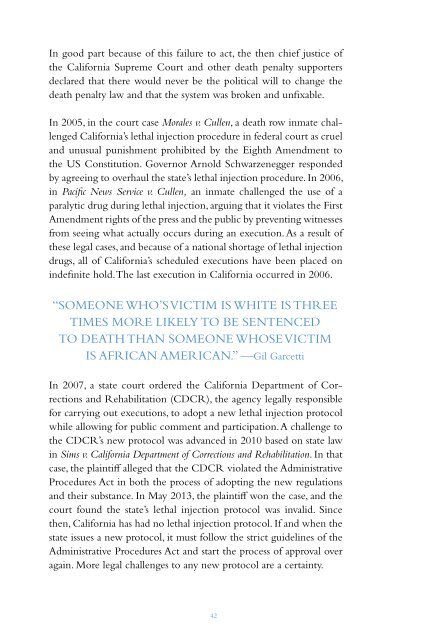PENALTY
DBk0302s7Xm
DBk0302s7Xm
You also want an ePaper? Increase the reach of your titles
YUMPU automatically turns print PDFs into web optimized ePapers that Google loves.
In good part because of this failure to act, the then chief justice of<br />
the California Supreme Court and other death penalty supporters<br />
declared that there would never be the political will to change the<br />
death penalty law and that the system was broken and unfixable.<br />
In 2005, in the court case Morales v. Cullen, a death row inmate challenged<br />
California’s lethal injection procedure in federal court as cruel<br />
and unusual punishment prohibited by the Eighth Amendment to<br />
the US Constitution. Governor Arnold Schwarzenegger responded<br />
by agreeing to overhaul the state’s lethal injection procedure. In 2006,<br />
in Pacific News Service v. Cullen, an inmate challenged the use of a<br />
paralytic drug during lethal injection, arguing that it violates the First<br />
Amendment rights of the press and the public by preventing witnesses<br />
from seeing what actually occurs during an execution. As a result of<br />
these legal cases, and because of a national shortage of lethal injection<br />
drugs, all of California’s scheduled executions have been placed on<br />
indefinite hold. The last execution in California occurred in 2006.<br />
“SOMEONE WHO’S VICTIM IS WHITE IS THREE<br />
TIMES MORE LIKELY TO BE SENTENCED<br />
TO DEATH THAN SOMEONE WHOSE VICTIM<br />
IS AFRICAN AMERICAN.” —Gil Garcetti<br />
In 2007, a state court ordered the California Department of Corrections<br />
and Rehabilitation (CDCR), the agency legally responsible<br />
for carrying out executions, to adopt a new lethal injection protocol<br />
while allowing for public comment and participation. A challenge to<br />
the CDCR’s new protocol was advanced in 2010 based on state law<br />
in Sims v. California Department of Corrections and Rehabilitation. In that<br />
case, the plaintiff alleged that the CDCR violated the Administrative<br />
Procedures Act in both the process of adopting the new regulations<br />
and their substance. In May 2013, the plaintiff won the case, and the<br />
court found the state’s lethal injection protocol was invalid. Since<br />
then, California has had no lethal injection protocol. If and when the<br />
state issues a new protocol, it must follow the strict guidelines of the<br />
Administrative Procedures Act and start the process of approval over<br />
again. More legal challenges to any new protocol are a certainty.<br />
In addition to the legal challenges, the CDCR’s supply of sodium<br />
thiopental, the lethal injection drug required under the regulations,<br />
has expired. The drug is no longer legally available in the United<br />
States and may not be imported under federal law. Thus, there is no<br />
legal source of the drug. Pentobarbital, another lethal injection drug<br />
used by some states, is also in short supply as the European manufacturer<br />
has cut off sales to US prisons.<br />
REPLACING THE DEATH <strong>PENALTY</strong> WITH<br />
LIFE IN PRISON<br />
In California, replacing the death penalty with life in prison without<br />
the possibility of parole can only be accomplished through a<br />
ballot initiative, since that is how the death penalty law was enacted.<br />
In 1978, 70 per cent of California voters passed the Briggs initiative,<br />
establishing the death penalty and specifying the criteria for eligibility.<br />
Given the current status of the death penalty in California<br />
and the general movement away from it across the nation, the goal<br />
of bringing a repeal initiative to the voters, while it may be viewed<br />
by some as audacious, is, at least in California, within reach.<br />
California sentences more people to death than any other state. As<br />
of this writing, it has nearly 750 prisoners on death row. California<br />
led the country with 24 death sentences in 2013, 13 of them coming<br />
from just two southern counties. While more than 800 people have<br />
been sentenced to death in California since 1978, only 13 executions<br />
have been performed. Of the people sentenced to death in California<br />
in the last 30 years, only 1 per cent have been executed. Most death<br />
row inmates die of natural causes.<br />
On a national level, the United States continues to move further away<br />
from the death penalty. Death sentences and executions are down in<br />
most states, and reported public support for the death penalty has<br />
declined significantly since the mid-1980s. California is not immune<br />
from this trend. An April 2011 poll by David Binder Research found<br />
that 63 per cent of California voters, across all parties and counties,<br />
support the governor converting all current death sentences to life in<br />
prison without possibility of parole. More Californians are realizing<br />
that the death penalty does not achieve swift and certain justice for<br />
42 43


